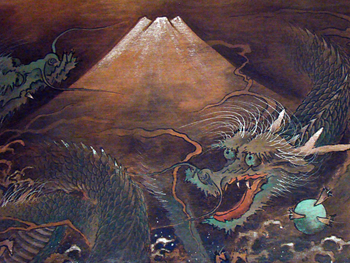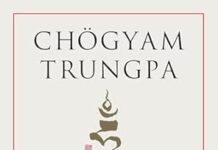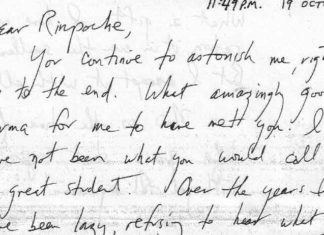
During his lifetime, we celebrated Chögyam Trungpa’s birthday in February. I don’t think we ever had an exact date, probably because Tibetans use a lunar calendar. In Born in Tibet, Rinpoche says that he was born on the first full moon after Losar. Losar, or New Year’s Day, is always on the new moon. So Rinpoche was born about two weeks after Losar/Shambhala Day. If you’d like to mark your calendars, his lunar birthday falls on March 8th this year. He would be turning 72. Four weeks later, on April 4th, we will marking the 25th anniversary of his parivirvana.
Chögyam Trungpa was born in the year of the Iron Dragon, which began on February 8, 1940, when Tibet was still Tibet, a feudal society isolated from the world. Beyond its snow capped peaks, World War Two was brewing, the buddhadharma was barely known, and most of Chögyam Trungpa’s western students were not yet born. Here’s what one astrologer says about those born in the year of the Iron Dragon:
Truthful but extreme, courageous but unyielding, Iron Dragons have a strength similar to the Fire Dragon. Iron Dragons succeed through determination. They are mighty and respect people who stand up to them. In troubled times, these Dragons make great allies, but become ferocious challengers. Iron Dragons can often calm others through their forceful personalities. They seek action, and things are never better than when they are defending a thought or belief about which they have complete faith. Iron Dragons like to lead, and have an effect that makes others want to follow them. Yet even if they attract no support they will fight alone.
Today is Shambhala Day/Losar 2012—the year of the Water Dragon, the sixth dragon year since Chögyam Trungpa’s birth. This got me thinking about dragon years. Have they been significant in some way during and since Chögyam Trungpa’s life? Here’s a very subjective look back at dragon years 1940, 1952, 1964, 1976, 1988, 2000, and 2012.
By 1952, the year of the Water Dragon, Chögyam Trungpa had already revealed a number of terma teachings, composed several sadhanas, impressed and intimidated his tutors, and met his root guru Sechen Kongtrul. But to my knowledge, we don’t know anything specifically about his 12th year. Perhaps there was some foreshadowing of the dark days that would soon follow for the Tibetan people. Meanwhile, many of his future students were young children living in 1950s American families, a world far from Tibet in every way imaginable.
By 1964, the year of the Wood Dragon, much had changed. Rinpoche had finished his training and grown to prominence as an accomplished and highly regarded lama. He had led a ragtag group of refugees across seemingly endless mountain ranges, left the reclusive land of snow, and entered the wide world: first India, then England. 1964 was his first full year in the West. Did he and Akong mark their first Losar in England in some way? This dragon year would be spent immersed in western culture, thought, and language at Oxford. Meanwhile, many of his future students were entering high school, listening to the Beatles and Dylan, and beginning to hear the distant beat of a different drummer.
The Fire Dragon year, 1976, was actually the first year that Rinpoche is known to have celebrated Losar after arriving in North America. Losar fell during the Karmapa’s second visit to North America, and Rinpoche celebrated it with the Karmapa in California. The Fire Dragon was a watershed year for Chögyam Trungpa and his students. Rinpoche gave many landmark teachings, including the Evam seminar in Boulder, the Buddha Nature seminar at Karme Choling, the Skillful Means and Wisdom seminars in the Bay Area, and many others. He received the first Shambhala terma teachings, including the practice of Ashe. Meanwhile, the Vajradhatu community hosted two major visits in 1976: Dilgo Khyentse Rinpoche, and the Karmapa. These visits were historic milestones in the transplanting of dharma in the West. The Fire Dragon also ushered in the beginnings of formal western service: the first court, the first formal dinners, first black tie ball. During the final month of the Fire Dragon (January 1977), Rinpoche bestowed the Vajrayogini Abhisheka for the first time in the West. But of all the landmark events of 1976, the most courageous and important was the empowerment of Thomas Rich as the Vajra Regent. The Fire Dragon year was indeed more than monumental.
Enter the Earth Dragon, 1988: the first full year of Chögyam Trungpa’s absence. The Vajra Regent was taking the reigns of leadership of Vajradhatu, and by the end of the year there was an explosion of controversy surrounding his leadership. By late 1988 and early 1989, the Regent and many of his followers had moved to Ojai, California. 1988 was also the year when several hundred Buddhists moved to Halifax. It was a year of migration and turmoil.
Had he lived, Chögyam Trungpa would have turned 60 in the year of the Iron Dragon, 2000. This was the year that his son, Sakyong Mipham Rinpoche, coined the term Shambhala Buddhism during the 2000 Kalapa Assembly in Sackville, New Brunswick. It was the harbinger of the many changes initiated over the past twelve years, blending the Buddhist and Shambhala dharmas into one presentation, one path. Which brings us to today: Shambhala Day 2012. What will the Water Dragon bring? Chögyam Trungpa’s community is now quite diverse, spanning the Shambhala mandala, and extending into the communities of many prominent Tibetan lineage holders. It also includes many unaffiliated, but dedicated, practitioners and students of all ages, many of whom never met him. The Shambhala path articulated gradually by the Sakyong beginning in 2000, now seems quite complete. Many have embraced this path, and many have not. Predictions anyone? What will this dragon year bring? How will we look back on it when the Wood Dragon arrives in 2024, the Fire Dragon in 2036?
Reades’ Comments
Here is a farflung prediction I am expecting there to be more Sakyongs and I also feel that they will be westerners and outside of the family lineage of Trungpa Rinpoche.
I think this has to be the case because of the decay of materialism in the west and the Age we are in.
I think at some point there will be more revealed teachings emerging in the west as the notion of basic goodness gains ground and people settle into practicing. Of course the former students not in SI are dispersed around the globe and they are creating emerging communities so by 2036 at the latest their children will be coming into their own and who knows what they will create and reveal.
I believe religious history in the west also tells us that in matters of faith things dont always go to plan and there are kind of completely off the wall connections to what is which motivate people to create new movements and communities. In addition yes the glimpse of enlightened society is many thousands of years old and we, you or I can not hedge it in within defined patterns even though we may wish, so the mishaps continue!
Well best for the new year of the Dragon!
-Rita Ashworth
















